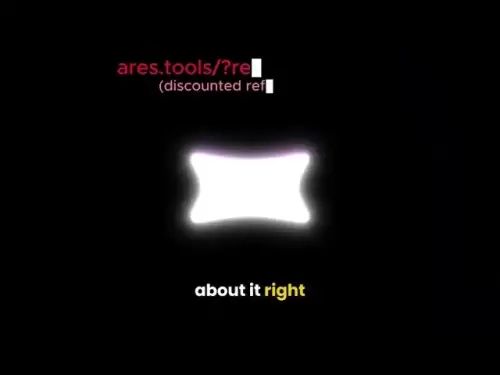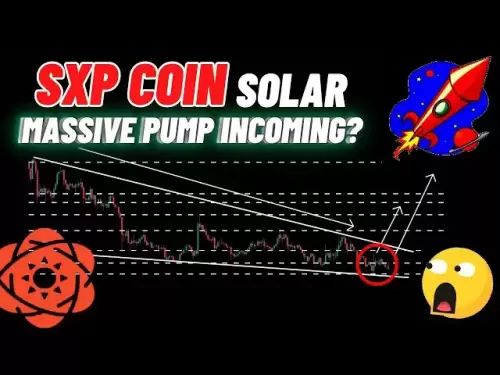-
 Bitcoin
Bitcoin $117500
2.04% -
 Ethereum
Ethereum $3759
3.02% -
 XRP
XRP $3.171
3.30% -
 Tether USDt
Tether USDt $1.000
0.03% -
 BNB
BNB $782.4
2.52% -
 Solana
Solana $187.2
5.62% -
 USDC
USDC $0.0000
0.02% -
 Dogecoin
Dogecoin $0.2380
5.26% -
 TRON
TRON $0.3175
1.07% -
 Cardano
Cardano $0.8227
4.03% -
 Hyperliquid
Hyperliquid $44.50
5.44% -
 Sui
Sui $4.020
10.07% -
 Stellar
Stellar $0.4396
6.28% -
 Chainlink
Chainlink $18.32
4.55% -
 Hedera
Hedera $0.2628
10.71% -
 Bitcoin Cash
Bitcoin Cash $554.8
4.90% -
 Avalanche
Avalanche $24.20
4.60% -
 Litecoin
Litecoin $113.7
2.31% -
 Shiba Inu
Shiba Inu $0.00001413
5.99% -
 UNUS SED LEO
UNUS SED LEO $8.984
0.11% -
 Toncoin
Toncoin $3.326
7.22% -
 Ethena USDe
Ethena USDe $1.001
0.00% -
 Uniswap
Uniswap $10.49
4.56% -
 Polkadot
Polkadot $4.092
4.02% -
 Monero
Monero $326.6
1.30% -
 Dai
Dai $1.000
-0.01% -
 Bitget Token
Bitget Token $4.570
2.49% -
 Pepe
Pepe $0.00001267
5.10% -
 Aave
Aave $297.3
3.10% -
 Cronos
Cronos $0.1344
4.10%
The rebound node of the weekly five consecutive positives superimposed on the daily KDJ oversold
A bullish rebound node emerges when five weekly green candles align with a daily KDJ oversold bounce, signaling high-probability long entry amid sustained uptrend.
Jul 24, 2025 at 05:43 pm
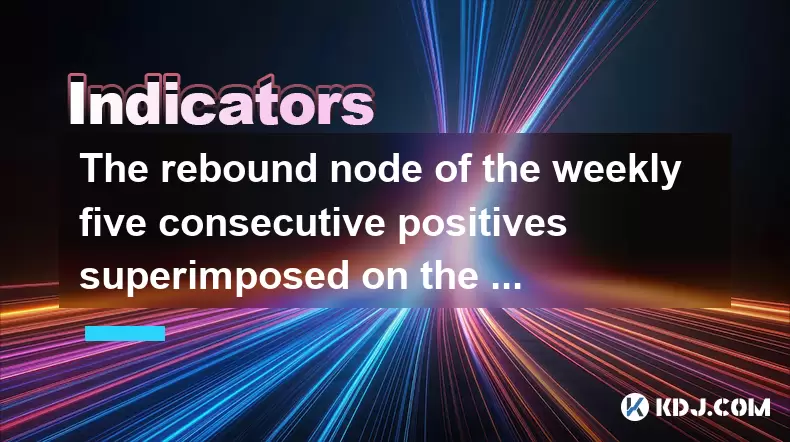
Understanding the Weekly Five Consecutive Positives
When analyzing the weekly five consecutive positives, it refers to a scenario in which the closing price of a cryptocurrency has been higher than the opening price for five consecutive weeks. This pattern is typically observed on the weekly candlestick chart and is considered a strong signal of sustained bullish momentum. Each green (positive) candle indicates that buyers dominated the market during that week. When this occurs repeatedly, it suggests that the upward trend is firmly in place, supported by consistent demand.
The presence of five consecutive green candles on the weekly timeframe carries significant weight because the weekly chart filters out much of the noise found in lower timeframes. Traders and analysts often treat such a pattern as a confirmation of a healthy uptrend. However, it's critical to note that even strong trends can experience pullbacks. The key lies in identifying whether the trend is continuing or if exhaustion is setting in. This is where additional technical indicators, such as the daily KDJ, become essential in providing a more nuanced interpretation.
Decoding the Daily KDJ Oversold Condition
The KDJ indicator is a momentum oscillator derived from the Stochastic Oscillator, widely used in cryptocurrency technical analysis. It consists of three lines: %K (fast line), %D (slow line), and %J (divergence line). When the KDJ enters the oversold zone, typically defined as values below 20, it signals that the asset may have been sold off excessively in the short term and could be due for a corrective bounce.
In the daily timeframe, an oversold KDJ suggests that short-term selling pressure has peaked and that the downward momentum is weakening. This condition often precedes a price rebound, especially when it coincides with other bullish signals. The %K line crossing above the %D line within the oversold region is considered a bullish signal, indicating a potential reversal. However, traders must exercise caution, as oversold conditions can persist during strong downtrends. The confluence with the weekly five consecutive positives increases the probability of a genuine rebound rather than a temporary bounce.
Interpreting the Confluence of Weekly and Daily Signals
The combination of five weekly consecutive positives and a daily KDJ oversold reading creates a powerful analytical setup. This confluence suggests that the underlying trend remains bullish, as confirmed by the weekly data, while the daily chart shows signs of short-term exhaustion after a pullback. This scenario often presents a high-probability buying opportunity for traders seeking to re-enter or initiate long positions.
The rebound node in this context refers to the precise moment when the price begins to move upward again after a temporary dip. Identifying this node requires monitoring both timeframes simultaneously. Key signs include:
- A daily candle closing above the previous low after the KDJ exits the oversold zone
- Volume increasing on upward moves, confirming buyer interest
- The %K line crossing above %D while both are below 20
- Price holding above a key support level, such as a moving average or trendline
When these elements align, the likelihood of a sustained rebound increases significantly. The weekly bullish structure provides the strategic context, while the daily KDJ offers tactical entry timing.
Step-by-Step Identification of the Rebound Node
To accurately identify the rebound node in this scenario, follow these steps:
- Confirm the weekly chart shows five consecutive green candles, ensuring each week’s close is higher than its open
- Switch to the daily chart and locate the KDJ indicator, ensuring it is set to the standard 9,3,3 parameters
- Check if the KDJ values are below 20, indicating an oversold condition
- Look for a bullish crossover where the %K line rises above the %D line within the oversold zone
- Observe price action for a bullish candlestick pattern, such as a hammer or engulfing pattern, near a support level
- Verify rising volume on the upward move to confirm participation from buyers
- Place entry orders just above the high of the bullish reversal candle, using a stop-loss below the recent swing low
This method ensures that both trend alignment and momentum reversal are accounted for. The weekly trend provides confidence in the direction, while the daily KDJ signals the optimal timing.
Practical Application in Cryptocurrency Trading
In real-world cryptocurrency trading, this setup can be applied across major pairs such as BTC/USDT or ETH/USDT. For example, suppose Bitcoin has posted five straight weekly gains, indicating strong accumulation. After a sharp correction due to profit-taking, the daily KDJ drops to 18, with %K at 16 and %D at 19. The next day, %K rises to 22 and crosses above %D, accompanied by a bullish engulfing candle on increased volume. This would be a textbook example of a rebound node.
Traders might:
- Enter a long position at the close of the engulfing candle
- Set a stop-loss at 3-5% below the entry, depending on volatility
- Target the previous weekly high as the initial profit objective
- Use trailing stops to capture extended momentum if the trend resumes
Platforms like Binance, Bybit, or TradingView allow users to set alerts for KDJ crossovers and candlestick patterns, enabling timely execution. Backtesting this strategy on historical data can help refine entry and exit rules.
Frequently Asked Questions
What is the ideal KDJ setting for detecting oversold conditions on the daily chart?
The standard KDJ configuration is 9,3,3, which is optimal for daily analysis. This setting balances sensitivity and reliability. Using a shorter period may generate false signals, while longer periods could delay detection.
Can the rebound node occur even if the weekly trend isn’t strongly bullish?
No, the validity of the rebound node in this context depends on the existence of a confirmed bullish weekly trend. Without five consecutive weekly positives, the oversold KDJ may indicate a temporary bounce in a downtrend rather than a sustainable reversal.
How do you confirm that the KDJ has truly exited the oversold zone?
The KDJ is considered to have exited oversold when both %K and %D rise above 20. A stronger confirmation occurs when the %K line remains above %D for two consecutive periods, indicating sustained upward momentum.
Is volume important when trading this rebound setup?
Yes, volume validation is crucial. A rebound without volume support may fail. Ideally, the reversal candle should show at least 20% higher volume than the average of the past five days, signaling active buyer participation.
Disclaimer:info@kdj.com
The information provided is not trading advice. kdj.com does not assume any responsibility for any investments made based on the information provided in this article. Cryptocurrencies are highly volatile and it is highly recommended that you invest with caution after thorough research!
If you believe that the content used on this website infringes your copyright, please contact us immediately (info@kdj.com) and we will delete it promptly.
- Pi Coin, Wallet Features, and Coinbase: What's the Buzz?
- 2025-07-26 18:30:12
- Worldcoin, Punisher Coin, and the Meme Coin Mania: What's the Haps?
- 2025-07-26 18:30:12
- Dogecoin Trajectory: From Meme to Mainstream and Beyond in Crypto
- 2025-07-26 17:10:14
- LasMeta, Pyth Network, NovaDrop NFTs: Decoding the Buzz
- 2025-07-26 16:30:12
- SHIB Long/Short: Riding the Shiba Inu Waves Like a Pro
- 2025-07-26 17:50:12
- VeChain (VET) Price Prediction: Will VET Reach $0.040 in August 2025?
- 2025-07-26 16:50:12
Related knowledge

What does it mean that the rebound is blocked after the moving average is arranged in a short position for the first time?
Jul 26,2025 at 10:51am
Understanding the Short-Term Moving Average ConfigurationWhen traders refer to a 'short position arrangement' in moving averages, they are describing ...

What does it mean when the price rises along the 5-day moving average for five consecutive days?
Jul 26,2025 at 08:07am
Understanding the 5-Day Moving Average in Cryptocurrency TradingThe 5-day moving average (5DMA) is a widely used technical indicator in cryptocurrency...

What does it mean when the price breaks through the 60-day moving average with a large volume but shrinks the next day?
Jul 26,2025 at 06:01am
Understanding the 60-Day Moving Average in Cryptocurrency TradingThe 60-day moving average (60DMA) is a widely used technical indicator in the cryptoc...

What does the sudden rise of ADX in DMI accompanied by +DI crossing -DI indicate?
Jul 26,2025 at 01:21pm
Understanding the DMI and Its Core ComponentsThe Directional Movement Index (DMI) is a technical analysis tool used to determine the presence and stre...
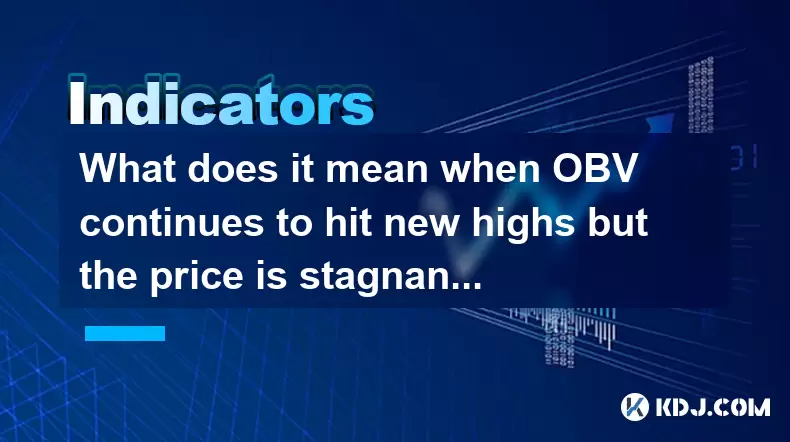
What does it mean when OBV continues to hit new highs but the price is stagnant?
Jul 26,2025 at 09:57am
Understanding the On-Balance Volume (OBV) IndicatorThe On-Balance Volume (OBV) is a technical analysis indicator that uses volume flow to predict chan...
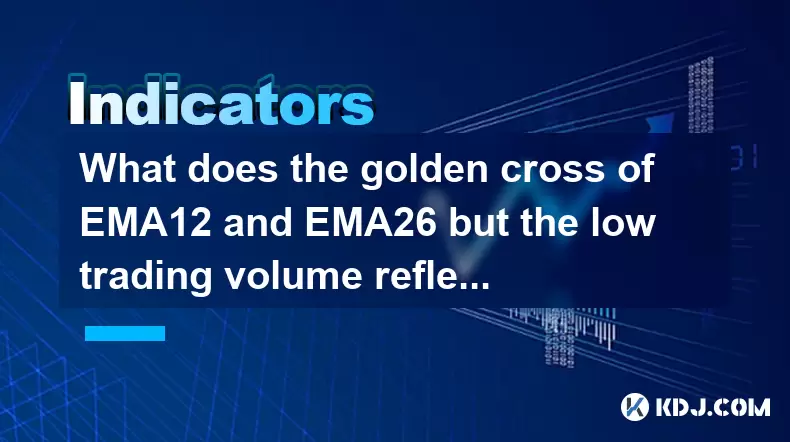
What does the golden cross of EMA12 and EMA26 but the low trading volume reflect?
Jul 26,2025 at 06:44am
Understanding the Golden Cross in EMA12 and EMA26The golden cross is a widely recognized technical indicator in the cryptocurrency market, signaling a...

What does it mean that the rebound is blocked after the moving average is arranged in a short position for the first time?
Jul 26,2025 at 10:51am
Understanding the Short-Term Moving Average ConfigurationWhen traders refer to a 'short position arrangement' in moving averages, they are describing ...

What does it mean when the price rises along the 5-day moving average for five consecutive days?
Jul 26,2025 at 08:07am
Understanding the 5-Day Moving Average in Cryptocurrency TradingThe 5-day moving average (5DMA) is a widely used technical indicator in cryptocurrency...

What does it mean when the price breaks through the 60-day moving average with a large volume but shrinks the next day?
Jul 26,2025 at 06:01am
Understanding the 60-Day Moving Average in Cryptocurrency TradingThe 60-day moving average (60DMA) is a widely used technical indicator in the cryptoc...

What does the sudden rise of ADX in DMI accompanied by +DI crossing -DI indicate?
Jul 26,2025 at 01:21pm
Understanding the DMI and Its Core ComponentsThe Directional Movement Index (DMI) is a technical analysis tool used to determine the presence and stre...

What does it mean when OBV continues to hit new highs but the price is stagnant?
Jul 26,2025 at 09:57am
Understanding the On-Balance Volume (OBV) IndicatorThe On-Balance Volume (OBV) is a technical analysis indicator that uses volume flow to predict chan...

What does the golden cross of EMA12 and EMA26 but the low trading volume reflect?
Jul 26,2025 at 06:44am
Understanding the Golden Cross in EMA12 and EMA26The golden cross is a widely recognized technical indicator in the cryptocurrency market, signaling a...
See all articles





















